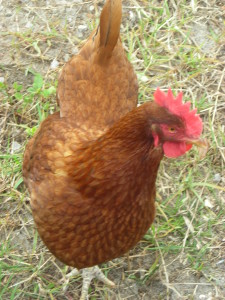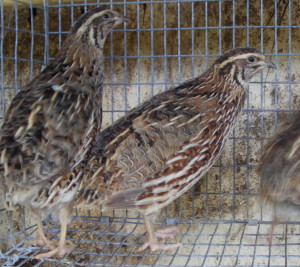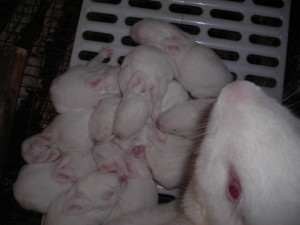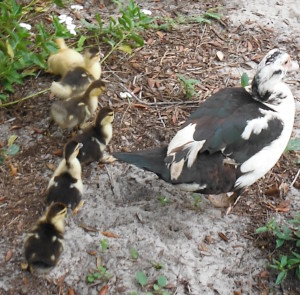Living 5o feet from another family makes certain choices VERY important. Your TV volume, height of your fence, amount of clothing to wear in your back yard, and what animals you can raise without causing grief for yourself as well as your neighborhood.
 I have always believed that, much like family, you are stuck with your neighbors for better or worse, so you may as well get along with them. So when I decided I wanted to start raising chickens, one of the first things I did was to speak to my neighbors about my plans. I found that not only do my neighbors not mind, most were excited to have chickens in the area, and most hinted about loving fresh eggs. (I also found out eventually that we are not the first family on the street to have chickens!) So we started raising chickens, and passing out eggs to neighbors when we had a surplus.
I have always believed that, much like family, you are stuck with your neighbors for better or worse, so you may as well get along with them. So when I decided I wanted to start raising chickens, one of the first things I did was to speak to my neighbors about my plans. I found that not only do my neighbors not mind, most were excited to have chickens in the area, and most hinted about loving fresh eggs. (I also found out eventually that we are not the first family on the street to have chickens!) So we started raising chickens, and passing out eggs to neighbors when we had a surplus.
A friend got me interested in coturnix quail, and I found that not only is their feed-to-egg ratio better than chickens, their space requirements and maturing time is less.
- Chickens take 21 days to incubate, 4-6 months of feeding, care and housing before producing a single egg.
Quail take 17 days to incubate, 6-8 WEEKS of feeding, care and housing before producing a single egg. - Chickens produce 180-300 eggs per year
Quail produce 300+ eggs per year - Chickens, per bird, need 3-4 square feet inside, plus a run or free ranging, or 10 sqft if coop kept.
Quail, per bird, need 16-25 square INCHES - Chickens require three pounds of feed for a pound of eggs
Quail require two pounds of feed for a pound of eggs.
 Quail need less space, less food, and less time. Add in the fact that they are relatively quiet, and when they ARE heard, no one says, “HEY! Someone has livestock over there!” It was a no-brainer. The only downside is that they require an incubator for raising each new generation. (But then so do most chicken breeds!)
Quail need less space, less food, and less time. Add in the fact that they are relatively quiet, and when they ARE heard, no one says, “HEY! Someone has livestock over there!” It was a no-brainer. The only downside is that they require an incubator for raising each new generation. (But then so do most chicken breeds!)
So we added quail.
Rabbits were added due, initially, to the poor soil here. I needed manure, and LOTS of it, in order to improve my garden soil, in self-watering containers at that time. Finding that rabbit manure is the only “cold” manure, and able to be placed directly into use without composting, I leaned more towards getting them. After hearing that my dad was told by his doctor to ONLY eat rabbit for health reasons (and laughing when he would load up my cooler with all the rabbit he had in the freezer ever time we’d visit), I started eating it myself when I could, and found it enjoyable as a chicken replacement. The final point that pushed me into getting them was the amount of noise they made-none.
I leaned more towards getting them. After hearing that my dad was told by his doctor to ONLY eat rabbit for health reasons (and laughing when he would load up my cooler with all the rabbit he had in the freezer ever time we’d visit), I started eating it myself when I could, and found it enjoyable as a chicken replacement. The final point that pushed me into getting them was the amount of noise they made-none.
An additional points in I found out later in favor of rabbits is that a doe rabbit that weighs 10 pounds can produce 320 pounds of meat in a year. I currently have THREE breeding does – that’s almost half a ton of rabbit meat a year, silently growing and enriching both my table and my garden soil!
All these animals do create unique problems to raising them in the city, main one for me being manure disposal. Worms, wasps, black soldier flies, and regular flies abound. The first three in that list are welcome, but the last one is a nuisance, and almost an overall deal-breaker with the wife….
 Until I learned of a homesteader’s best friend for cleaning up messes- Muscovy ducks. Excellent fly-catchers, mothers, egg-layers, dropped-feed cleaners, foragers, and yes, meat producers. Due to their tropical origin, they require less swimming water, are tree roosting birds, and are well-acclimated to my climate.
Until I learned of a homesteader’s best friend for cleaning up messes- Muscovy ducks. Excellent fly-catchers, mothers, egg-layers, dropped-feed cleaners, foragers, and yes, meat producers. Due to their tropical origin, they require less swimming water, are tree roosting birds, and are well-acclimated to my climate.
But they had me at “fly-catchers”. We added those too.
Other things I’ve found since getting each animal type is my interaction with each eases my mind, and has a calming affect. In this time of uncertainty and dwindling freedoms, I’m finding it a nice getaway to have something that I have almost complete control. Each mistake is mine, as is each success. Both are important to me.
With more space, or a different locale, I’d probably have different animals, pigs, goats, sheep, pigeons, and guineas all come to mind. But, for now, these are the cards I’ve been dealt as far as what works here. I’m good with it.
Definitely a hand worth playing….
=======================================================
Thanks for (re) reading this post. My reasoning hasn’t changed, I still feel these are the best options…for ME. Your choices will probably differ. That’s the beauty of this whole project – everyone has a different answer. And if we can learn a little beach from each other, so much the better.
Peace,
db
Hmmm, quail you say? I should have thought of that.
You are a funny guy….I need to return that favor sometime, and get you sucked into something that goes on forever….
I’m a bit further out of town than you, and have an acre, so I’ve got a few more options, but I enjoyed reading your list and your reasoning.
I’ve currently got rabbits, ducks (pekins, Indian runners and muscovies), and chickens (Australorps). They’re all going well, although I’d like to streamline the feeding and watering systems before committing to any more additions.
You’ve got me interested in quails now. I’ll have to look into them some more. I’ve seen a few people selling them locally, so it shouldn’t be too hard to get started. Do you eat them? Are they difficult to process? One of the attractions for me of rabbits over ducks and chickens was the quicker and simpler processing :-).
We raised 3 pigs last year, and that went very well, although they do demand a bit of time and effort. I simply couldn’t commit to taking them on again this year, but will again in the future. I’d like to try lambs and goats, too – probably just start with some wethers, and then decide if I want to get into breeding them.
Pigeons are also on my list to investigate. They seem pretty low maintenance. Bees are likely to be coming soon too, with luck.
I’ve enjoyed reading your blog – keep up the great posts!
Water is a big deal here with our heat, so I’ve installed a gravity fed automatic watering system. Its simply a bucket wit ha float valve attached to my well. The bucket sits up higher than my cages, so it feeds watering nipples in each cage. I believe I got it from Bass, a supplier of rabbit cages and such. WELL worth the money!
Feeding is done daily, not any way around it that I’ve seen, though I do use “J” feeders for all my animals except the quail. For them I have a homemade gravity feeder that I fill about once a week.
Quail can be processed VERY easily, if you peel the skin off, otherwise, plucking is the same pain in the rump as any other bird, they are just smaller. Tasty either way though! I will say I mostly keep them for eggs.
Pigs, the small potbellied kind that get to about 50 pounds, are on my radar, as are small goats, but I’m pushing things a bit as it is here in town.
I’ve actually made some contacts with pigeon breeders, and I’ve gone to a local show. They are very low maintenance, but also aren’t big producers. I’ve always wanted bees, but the wife fears them, so they aren’t an option, sadly.
I’ll do what I can to keep the posts coming…you’ll have to be the judge on how great theyare though
Thanks for the kind words,
db
Awesome, thanks for the follow-up info. I’ve got nipple waterers for my rabbits, but I’m having some teething problems. First problem was I ran the lines too close to the cages, and they chewed through them! Will get them fixed up this week, hopefully.
Will get them fixed up this week, hopefully.
The main feed/water problem I have is with the poultry. The ducks mess up the water very quickly, so I have to empty and refill containers every day. I’ve bought some poultry nipples for them, but haven’t got around to installing them yet. I’ve started using home-made PVC pipe J feeders, and they’re working well, although I need to net over the top of the pens to stop wild birds from eating all my feed.
My birds all use a nipple waterer with a 2 inch basin below it…
Similar to this:
http://amzn.to/URr13W
Do those cup waterers work OK with ducks? I was going to get some, but was advised by the supplier that the ducks will fill them with mud and cause them to leak.
Mine haven’t had any problems…but they also have a small 30 gallon pond to play/drink in. Never had any mud issues in the drinker though
It’s the killing that I can’t do. I just can’t. I understand that eating meat is natural. Meat comes from animals. That meat in the store was once a fine proud cow or pig or bird. I know. I just can’t kill an animal. I have a PET rabbit, even. I can’t kill his brethren. It would be fun to have chickens. Raise them, have eggs, let them fertilize the garden I have space for but haven’t put in because I kinda hate vegs, but I just can’t kill them and that’s the end game of having chickens or rabbits or anything. I guess if I HAD to, I would, but…
Thanks for the time and effort to comment. And for what its worth, I agree it IS a difficult thing.
My reasons are the health of my family. Read this:
http://floridahillbilly.com/why-grow-your-own-food/
then read this one on how I feel about killing animals for food.
http://floridahillbilly.com/one-bad-day/
Its NOT easy for me, and I’ve been harvesting animals since I was 8 years old. In my opinion, if it ever becomes easy, you should seek professional help.
Love your blog. I am an urban homesteader/prepper in S. Hillsborough Co. I live on a corner so I am able to have Nigerian Dwarf goats since they are the size of a medium dog. I have rabbits, chickens, and Muscovy’s and your right. The Muscovy’s are priceless.
Thanks! I want to try goats, but I prefer to stay married Honey bees also fall under that category…
Honey bees also fall under that category…
Weather and insects aren’t the only thing I have to contend with !
What kind of rabbits are you raising?
I have Altex and New Zealand Whites.
Same as me! Where’d you get the AlTex???
A man in Brooksville. They supposedly came from Texas A&M stock.
I got mine from a guy that got his from Brooksville. Our rabbits are cousins
I have been thinking of raising quail. Right now we raise chickens for eggs and rabbits for meat and live in an HOA. So quite and clean is a must. We tried pekin ducks, but they where noisy and extremely messy.
Quail are a mighty fine “Stealth” option for raising in town….